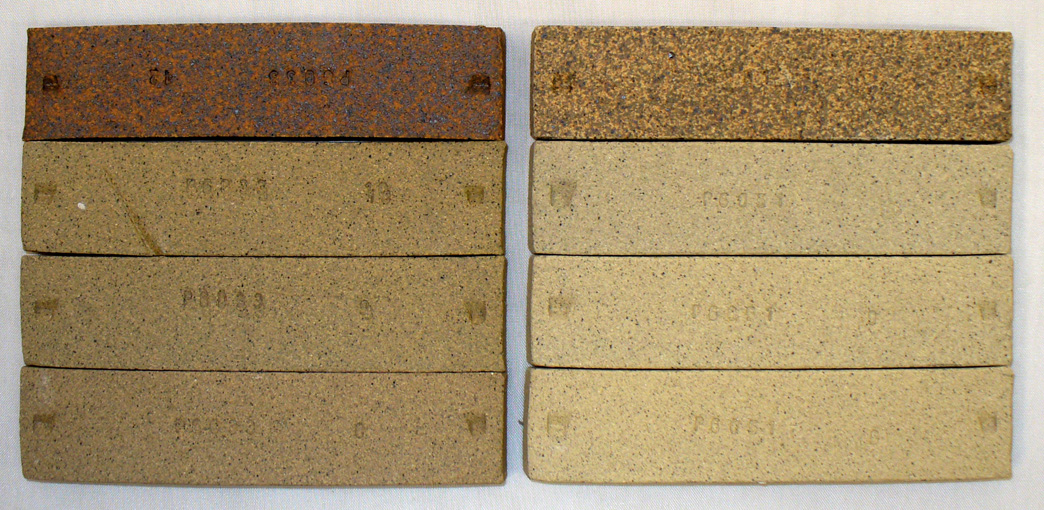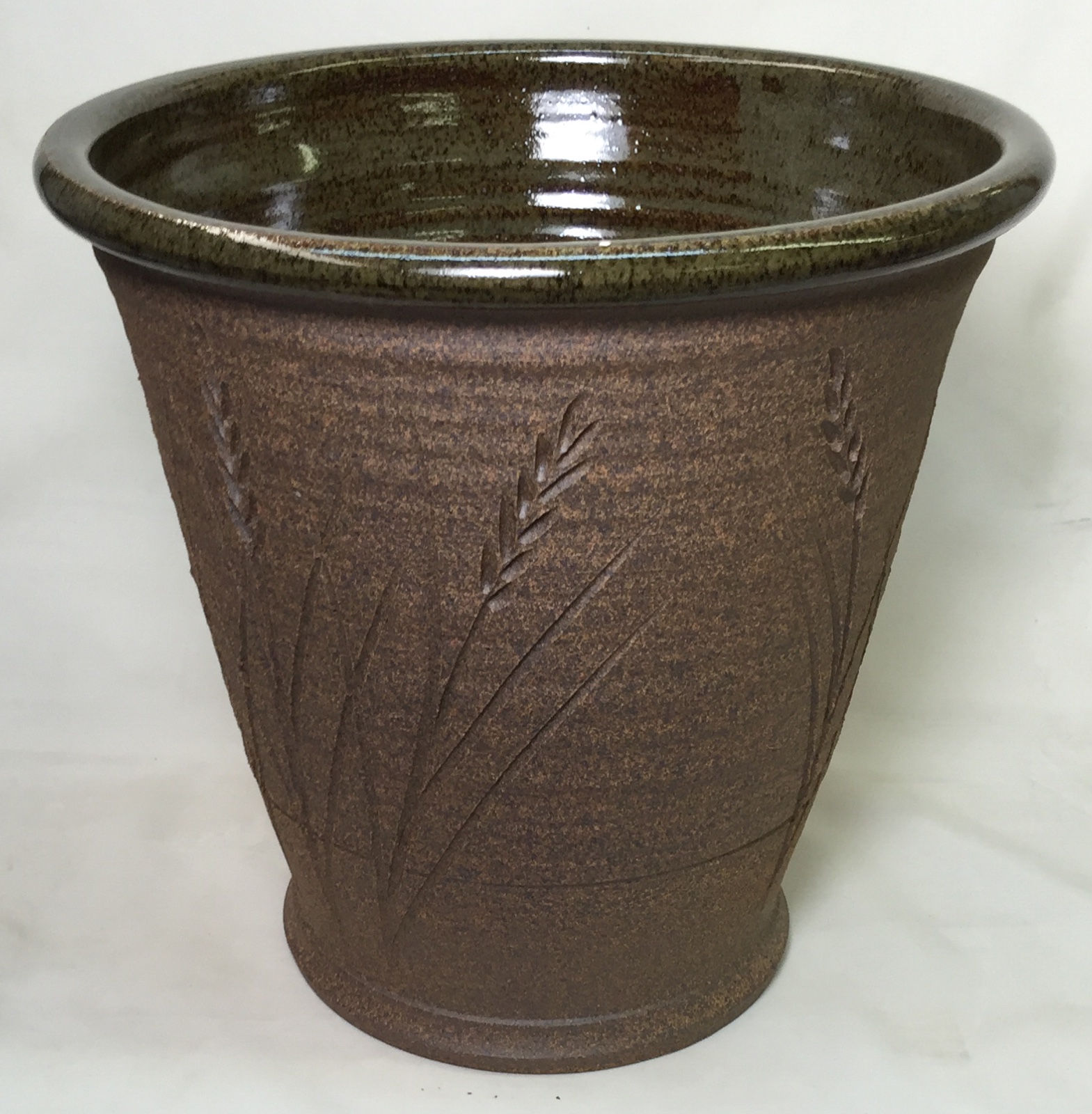H440
Description
Attractive high temperature, sandy textured, plastic, semi-vitreous, dark red speckled burning, native body for reduction fired iron stoneware. H440 displays an attractive mottled surface with a range of deep reds and browns when fired in cone 10 reduction. H440 is not a vitreous body. The body is best suited for decorative pieces large or small (vases, bowls, planters, etc.)
Process Properties
H440 is dark brown in pugged form. It has good plasticity but has significant kaolinized sand in its recipe. Thus it has a more sandy texture during throwing (more than 443). It has a wide distribution of particle sizes in the plus 200 mesh range producing a high dry density and strength.
H440 has a fairly high drying shrinkage and thus care and attention during drying are necessary for larger pieces, especially flat plates, shallow bowls, and sculptural ware. Cover pieces to make sure they dry evenly, take extra time drying if needed, and start the kiln slowly (candle overnight) for final water expulsion.
Firing

These test bars (left to to right) compare H440 and H443 at cone 10R (top) and cone 10, 8 and 8 oxidation.
H440 is a deep red firing iron reduction body. The significant Fire-Red native clay complement in its recipe is the reason for the attractive color. Like other bodies of this type, H440 has been formulated so that cone 10R is at its transition point from a light brown to a dark red-brown. When fired just right the surface is a patchy network of darker vitrified areas beginning to invade the lighter-colored matrix. If over-fired or over-reduced the surface will burn a dark solid red brown. Good color is possible as low as cone 8 reduction (where it is redder).
H440 contains significant amounts of iron stone concretion particles which melt vigorously in high-temperature reduction and which blossom on the base surface and bleed up through glazes. The degree to which these speckles melt and develop depends on the degree of reduction.
H440 can be fired in oxidation, but its color is much lighter; a leather greenish tan with a very fine speckle. It will tend to blister and bloat sooner in oxidation (i.e. cone 11) because the coarser particles in the clay are much more active in producing gaseous by-products during decomposition.
Glazing
Since H440 is high in iron and fires to a dark color, the finely divided iron in the clay will bleed into glazes. For example bright glazes will not be nearly as vivid as they would be if used on buff stonewares. On the other hand, this effect will enhance the appearance of earthtone and variegated glazes.
H440 has a high porosity so the fired body will tend to absorb water. For functional ware it is important that glazes not be crazed (strength can be significantly impacted if glazes do not fit).
Glaze Recipes
Commercial brush-on glazes: They may or may not fit our clays (check for glaze fit using a BWIW test or similar). For brightly colored glazes (especially with layering) do a leach test (e.g. GLLE test). Consider using a transparent or white liner glaze for food surfaces.
Mixing your own glazes is practical (with our clear guidelines even beginners can make dipping glazes that go on silky smooth and evenly and dry in seconds). If you already do this using recipes from the web, be careful. High-feldspar glazes (having more than about 35%) often craze. Some recipes rely on high melt fluidity to encourage crystallization and variegation (often because of inadequate SiO2 and Al2O3 or containing Gerstley Borate or Frit), view these with suspicion for leaching and cutlery marking; test them well (also test the additionless versions). Be suspicious of any glaze not having good documentation.
Consider using our G1947U glossy or G2571A matte base recipes, just add colorants, opacifiers, variegators (you will find links to much more information and pictures about these). If you have a recipe that is troublesome, consider transplanting its opacifiers, colorants and variegators to these bases instead. http://ravenscrag.com and http://albertaslip.com also have many recipes that work well on porcelains.
Crazing: Functional ware must remain craze-free (crazing is unsanitary and drastically reduces ware strength). Even though ware may not be crazed out-of-the kiln it may do so with time. Do cycles of a boiling water:ice water immersions (BWIW test) on a piece to test glaze fit (by stressing it to bring out any crazing or shivering tendencies).
Thixotropy: If you want the best application properties for one-coat dipping, consider creating a thixotropic slurry. Thixotropic glazes are creamy because they have been thinned and then gelled by the addition of a flocculant.
For slip decoration and engobes be careful to match the fired shrinkage of the slip with the body. Where we do not recommend a specific engobe recipe, consider one based on the body itself. Add 2% VeeGum or Bentonite (the extra stickiness helps it adhere well to leather hard ware). Be careful about adding fluxes (e.g. frit), this increases fired shrinkage creating a mismatch with body that can cause flaking (and can compromise engobe opacity).
If you want to develop and mix your own glazes and engobes consider getting an account at insight-live.com. You can organize a methodical development program and adopt better methods of testing (e.g. melt fluidity, thermal stress, slip-fit tests).
Thermal Expansion
We do not supply thermal expansion values. If a chart is supplied here, please view it only as a way to compare one body with another. Please note that, although you may calculate the thermal expansion of a glaze, this cannot be done for clay bodies since they do not melt. The best way to fit glazes to clay bodies is by testing, evaluation, adjustment and retesting. For example, if a glaze crazes, adjust its recipe to bring the expansion down, fire a glazed piece and thermal stress it (using an IWCT test, 300F into ice-water). If it still crazes, repeat the process.
Physical Properties
Drying Shrinkage: 6.0-7.0% Dry Strength: n/a Water Content: 20.0-21.0% Drying Factor: C120 Dry Density: n/a
Sieve Analysis (Tyler mesh):
+48: 0.0-0.5% 48-65: 1.0-3.0 65-100: 4.0-6.0 100-150: 2.5-5.0 150-200: 4.0-7.0 200-325: 6.0-10.0
Fired Shrinkage:
Cone 8: 4.5-5.5% Cone 10: 5.0-6.0 Cone 10R: 5.0-6.0
Fired Absorption:
Cone 8: 4.0-6.0% Cone 10: 3.0-4.0 Cone 10R: 2.5-3.5

